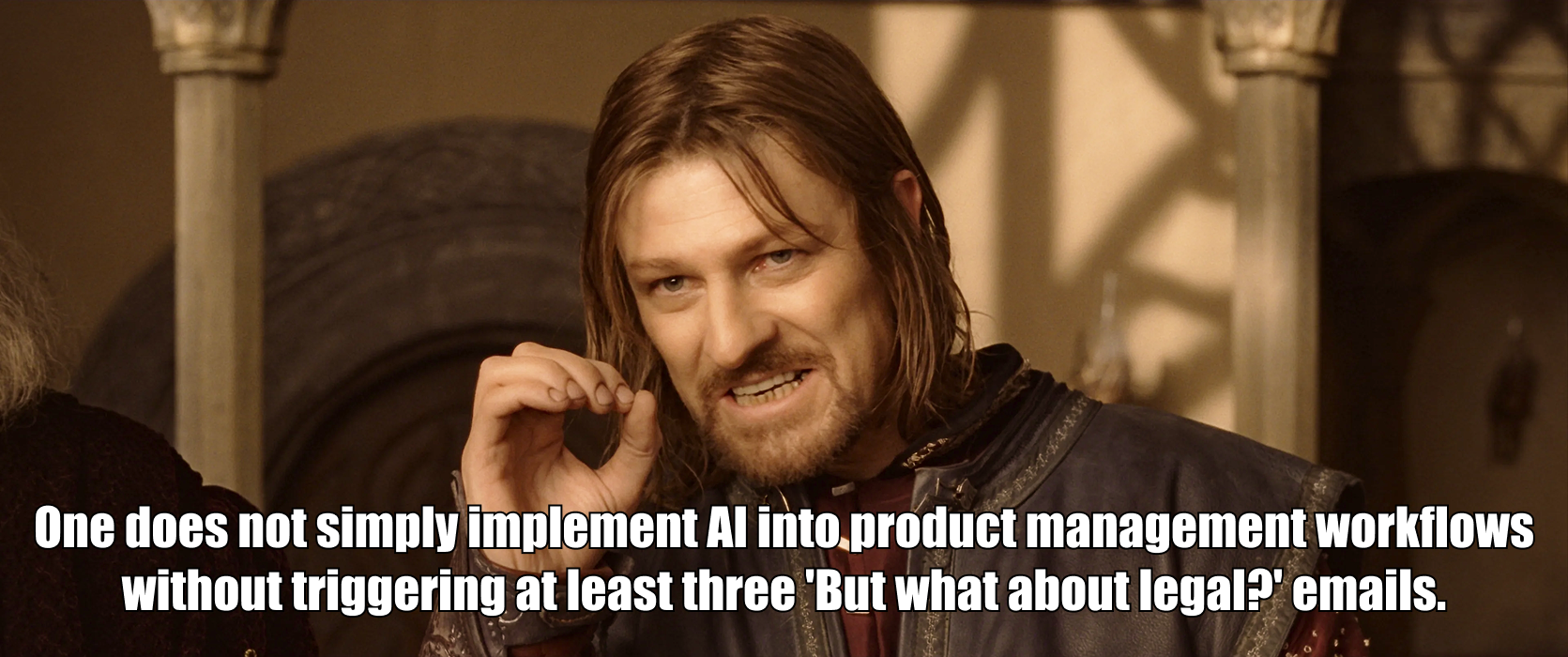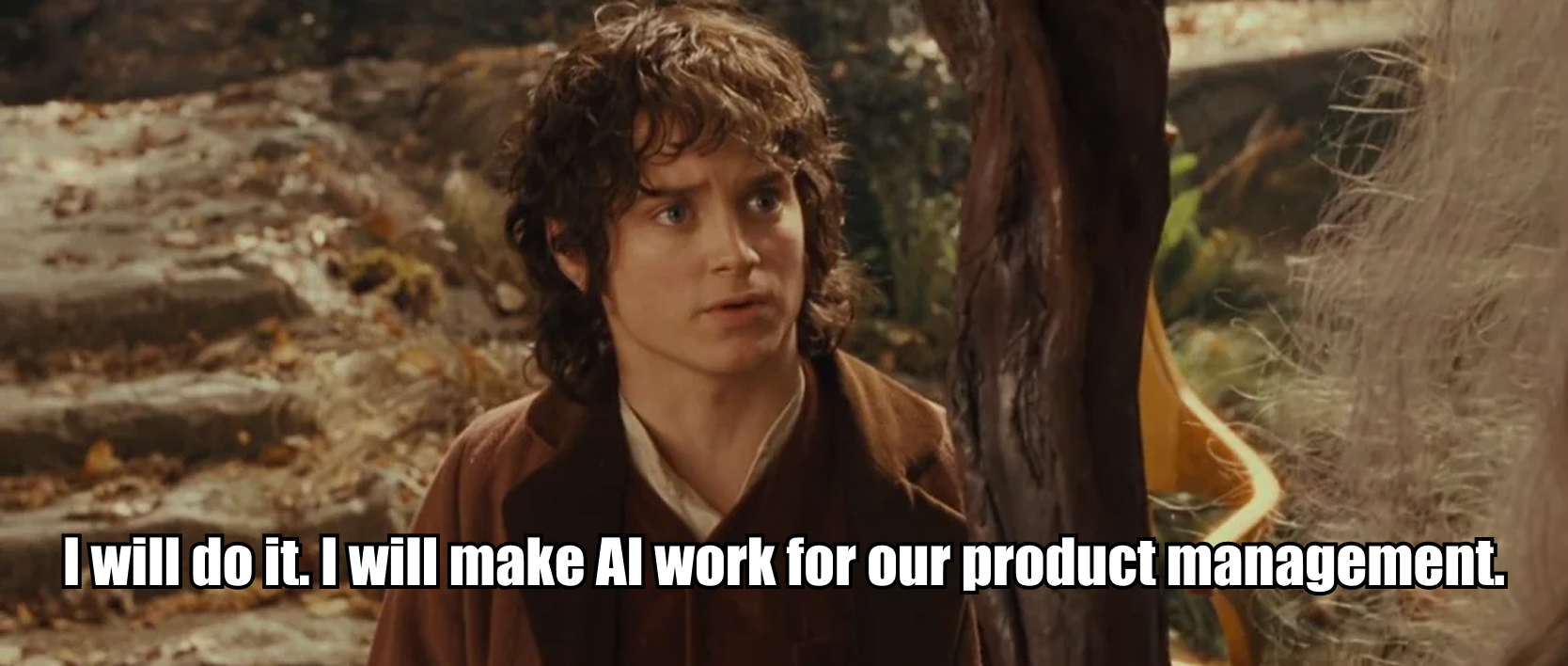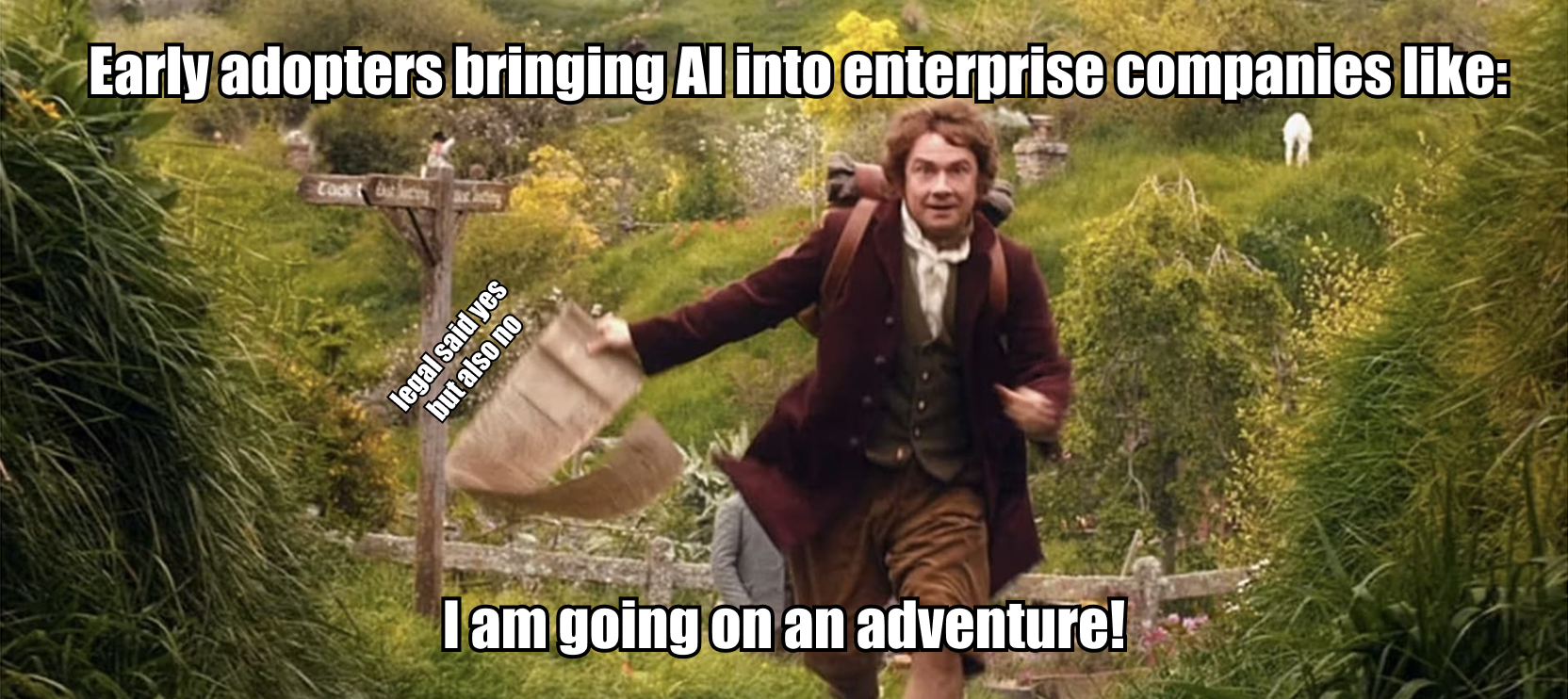AI in Product Management: Yes, It's Scary, But It's on You to Go First

Status Check: AI Is Sitting in the Backlog
If you've tried bringing AI into your team, you've probably run into this: "But what about data privacy?"
Or this: "We're not ready yet."
Maybe also a careful "Let's wait and see how it turns out for others."
It's not that your company doesn't believe in AI. It's that nobody wants to be the first to say yes. The risk of approving something is visible. The benefits? Still abstract – until someone proves it.
That's where you come in. This blog post will explain, why nobody wants to be the one shouldering the risk, but why you should do it anyway. And we will also show you how to build the case for AI adoption – even in the most skeptical environments.

We Know Why You're Hesitant to Take a Risk
As a Product Owner, making decisions is your job. It's literally in the title. You're the one who has to push things forward, even when it's uncomfortable. But sometimes, that's easier said than done.
Say there's a new feature idea: a redesigned onboarding flow that helps new users reach their "aha moment" faster. Right now, many drop off before they even understand how your product solves their problem. If you fix that, you could boost conversion after the free trial, reduce support tickets, and finally stop hearing "Why is your UX so clunky?" on sales calls.
Based on your data, there's a 70% chance it'll be a hit. But the new flow touches important parts of the product. There's a 10% chance it breaks something for enterprise customers who rely on custom setups and haven't been fully migrated to the new system. And what if people can't log in on launch day?
The rational choice? Take the bet. The odds are on your side.
But psychologically? The risk of being wrong outweighs the reward of being right. If it works? Everyone is happy. You might get a Slack emoji parade and a quick "nice work" in the retro. But if that 10% risk turns into reality? You're the person who made "that call". It will be picked apart in every meeting. Leadership asks why there wasn't more testing. Support is on fire. You're writing hotfix tickets at 9 p.m. The spotlight is no longer on the problem – it's on you. One visible mistake could damage your reputation and stick with you longer than seven quiet wins.
So the safe move wins: Tweak the backlog. Push a minor UI change. Keep things stable.
But At What Cost?
Voilà. This is how teams stagnate. When every decision is weighed down by fear of failure rather than the potential for success, innovation dies. The teams that take smart risks will always outpace the ones that don't.
As a PO, your job is to decide – especially when it's tough. You're the one driving the product forward. That means accepting uncertainty, taking calculated risks, and standing behind your decisions.
You're not a PO? You're a CEO, an executive manager, or anyone responsible for the environment you teams work in? Even better! We're so glad you're reading this: Because you can fix this. If failure is punished more than success is rewarded your teams will always hesitate. So be the one who creates an environment where people aren't afraid to experiment – where a feature that flops is seen as a learning opportunity, not a career risk.
So whoever you are: We're sure you don't want a team that plays it safe. You want a team that builds, that moves, that pushes your product forward.
AI Is One of Those Risks
Right now, everyone's talking about AI. It's the headline, the hype, the "next big thing." But here's the truth: most teams aren't doing anything meaningful with it. They're waiting. Watching. Dabbling. Very few are actually integrating AI into their workflows in a way that drives real impact. That's your next opportunity: To turn potential into progress while everyone else is following the news on LinkedIn.
We know, everyone is telling you this right now. But: AI isn't some distant revolution – it's already here in your daily work. Or it could be: It's the teammate who never forgets, who always knows where the documentation is, and who doesn't mind reviewing and improving the same Jira ticket for the 10th time.
You're not betting on magic. You're betting on:
- Onboarding new PMs or devs in days, not weeks. Because AI gives newcomers instant access to product knowledge, previous decisions, and past context.
- Sharper priorities and faster delivery. Because AI connects feedback, goals, and delivery work, then helps you write clear, complete stories in minutes, not meetings.
- Staying aligned without chasing updates. AI keeps everyone on the same page by summarizing Slack threads, meetings, and decisions – so your team can act, not ask.
That's the kind of help AI offers. Right now.

How AI Can Solve Your Product Challenges (Right Now)
If your Slack is full of half-answered questions, your roadmap keeps shifting, your backlog is a graveyard of "maybe someday," and your best ideas are stuck in your head because writing them down takes too long… You're not doing it wrong. That's just product life.
But it doesn't have to be quite this chaotic. Of course, AI won't solve everything. But it can take the edge off the chaos. It can give you breathing room. Here's what that actually looks like:
- Onboarding drags on? Give new hires an AI assistant that answers product questions 24/7. Instead of waiting three days for someone to explain the customer journey, a new PM asks the AI: "What's our current onboarding flow for user segment B?" and gets a clear, contextual answer in seconds.
- Searching Confluence is a pain? Let AI fetch the most relevant answer instantly. A designer looking for API documentation doesn't dig through old pages and finally interrupts a teammate mid-focus. They just ask: "Where's the latest API doc for the payments module?" The AI finds it. Done.
- Communication between teams breaks down? Use AI to translate, summarize, and clarify across silos. Engineering drops technical notes into Jira. AI turns them into product-friendly summaries. No more "Wait, what are we actually building?" in planning meetings.
- Customer feedback piles up? Use AI to analyze, cluster, and point out what matters. Instead of reading 300 tickets manually, AI tells you: "65% of feedback mentions confusion during signup." Now you know where to focus.
- Unclear requirements create extra meetings? Let AI spot open questions before developers do. While writing a ticket, the AI asks: "Which platforms should this support?" Now you fix the unclear parts before it causes long discussions later.
This isn't theory. These are things you can try next week.
The Hidden Cost of Playing It Safe
Here's the irony: doing nothing feels responsible. It's familiar. It's "safe." But it's the riskiest choice in the long run. Here's what it actually costs:
Three devs that spend an hour each per week rewriting tickets manually. A product manager who wastes time copying OKRs into 4 different planning tools. A hotfix release because QA missed a bug – because no one had time to write test cases. Strategy drifting off because no one has time to dig through 200 support tickets, 42 Slack threads, and the last meeting notes to find the signal in the noise.
And whoops – it's already the next quarter.
Meanwhile, teams who embraced AI six months ago? They're not stuck cleaning up the backlog. They're shipping.
How to Get AI Started (Without Asking for Permission)
AI doesn't get blocked because it's too expensive or too complex. It gets blocked because it's new. Unfamiliar. A little scary. People worry:
"What if it doesn't work and I look bad?"
"What if legal says no?"
"What if we roll it out and nobody uses it?"
"Maybe we just wait a few years and see what others do?"
That's why the smartest move is simple: Don't ask for a rollout. Just try something. Pick one small, annoying part of your workflow. Find out what AI can do about it. Try it out. Track the result. Don't make it a proposal – make it a proof of concept. Here's how to do it:

1. Make It Tangible
Don't talk about AI. Show what it can do. For example, you could:
- Compare a manual bug ticket to one written with AI. One of our Product Copilot users told us the process went from 45 minutes down to 7 – and the quality improved.
- Rewrite a vague user story with AI. Share it with your team in the next refinement session. Ask them for feedback. Another PO said that her team commented on the clarity of her stories during Planning – without her saying a word about using a new AI tool for that.
You don't need to sell the idea. Just make it obvious that it works.
2. Make It Safe
Start small. Pick a corner of your work where you feel automation would be useful – analyzing customer feedback, automating bug reports, writing stories – and test AI there. You don't have to pitch a company-wide rollout right away. Use test data. Try a free trial. No risk, no drama. Once you see it works, show the results to your team, your colleagues, your boss. You won't be pitching a tool or "some AI hype". You're sharing results.
Once you can prove the value, asking to integrate AI into your workflows won't feel like a risk – just common sense.
3. Make It Real
Want to explain the value? Don't use buzzwords – use numbers:
- "This replaces 80% of my manual grooming work."
- "We're losing 12 hours a month doing this by hand."
- "If each dev saves 5 minutes a day, this pays for itself in a week."
And just like that, you're not asking for permission – you're showing what's already working.
Be the One Who Goes First
Every breakthrough starts with someone saying: "Let me show you." If you're reading this, you already believe in the potential of AI in product management. You know it won't just save time – it will raise the bar.
Now your team needs someone to go for it when it's easier to wait. You can be that person.
And When You Do? You Change the Game
You'll reduce noise, rework, and unnecessary meetings.
You'll ship faster.
You'll build better products with less stress.
And most importantly? You'll have created proof. Others will follow – because you made it real.
But… Where should you start?
If you're not sure where to start, that's okay. We've put together 5 prompts you can try today to see how AI can support your product work. Just copy-paste them into ChatGPT. Try them out and let us know what you think. We're sure you'll see some great results.
But if you want to see what it can really do: We built Product Copilot, an AI tool that gives product teams like yours real, practical support right inside your Jira. It writes tickets, summarizes feedback, answers product questions, and helps you move faster without losing clarity.
Check it out. If you're interested, you can start a 28-day free trial. No worries, you're not entering a contract. It's just a chance to try things out and see what happens when AI actually works for you.
This is your chance to go first. To show what's possible.